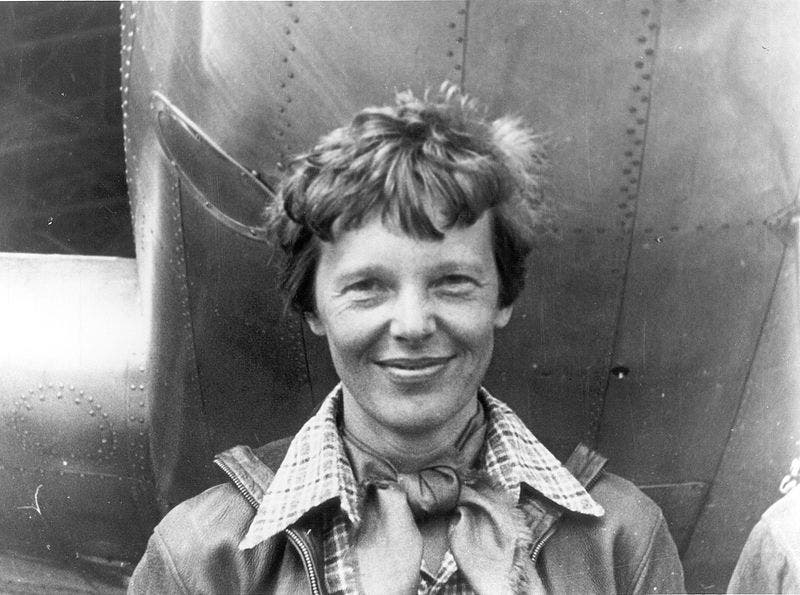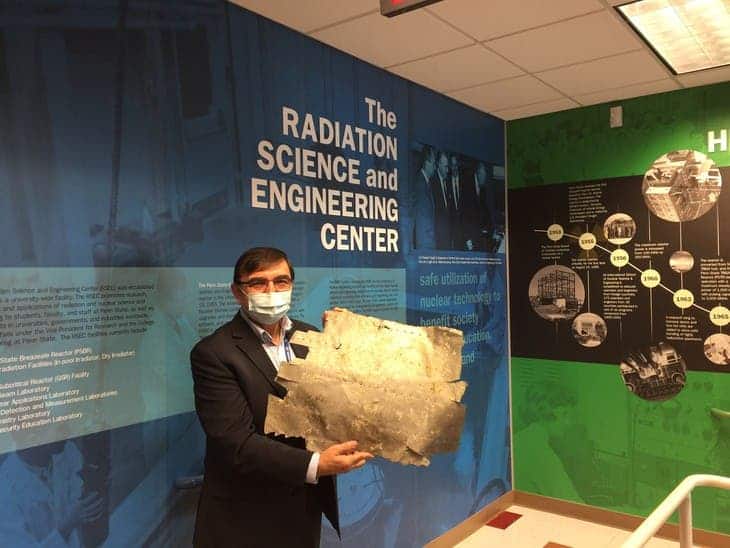
Earhart beneath the nose of her Lockheed Model 10-E Electra, March 1937,
Oakland, California, before departing on her final round-the-world
attempt prior to her disappearance.
Credit: Wikimedia Commons.
From ZMEScience by Tibi Puiu
A metal plate thought to have once belonged to Earhart's plane was probed for hidden secrets using neutron beams.
One of the bravest women of the 20th century, Amelia Earhart, vanished unexpectedly during her attempt to fly around the world.
Now, scientists have turned to nuclear technology to analyze a piece of metal debris that some suspect was part of Earhart’s wrecked plane. In doing so, they hope to piece together the final moments of the pioneering aviator’s final living hours.
A tragic end to a brave pioneer
Amelia Earhart was the first female pilot to fly across the Atlantic Ocean.
In 1937, Earhart and her navigator, Fred Noonan, were flying their Lockheed Model 10-E Electra on an even more ambitious quest: flying around the world.
On July 2, 1937, they were about six weeks and 20,000 miles into their journey when their plane suddenly crashed en route to Howland Island in the Pacific, which is halfway between Hawaii and Australia.
Howland island with the GeoGraage platform (NGA/NOAA source)
The Howland Island is a flat sliver of land about 2,000 meters (6,500 feet) long and 460 meters (1600 feet wide), so it must have been very difficult to distinguish from similar-looking clouds’ shapes from Earhart’s altitude.
Of course, Earhart and Noonan were well aware of the challenges, which is why they had an elaborate plan that involved tracking their routes using celestial navigation and linking to a U.S. Coast Guard vessel stationed off Howland Island using radios.
But despite their well-thought-out contingency plans, the pair were simply flat out of luck.
But despite their well-thought-out contingency plans, the pair were simply flat out of luck.
When they took off, witnesses reported that a radio antenna may have been damaged by the maneuver. On that morning, there were also extensive overcast conditions.
On the morning of July 2, 1937, at 7:20 AM, Earhart reported her position to the crew at the Coast Guard vessel, placing her plane on a course at 32 kilometers (20 miles) southwest of the Nukumanu Islands.
“We must be on you, but we cannot see you. Fuel is running low. Been unable to reach you by radio. We are flying at 1,000 feet.”
The ship replied but there was no indication that the signal ever reached Earhart’s plane.
“We must be on you, but we cannot see you. Fuel is running low. Been unable to reach you by radio. We are flying at 1,000 feet.”
The ship replied but there was no indication that the signal ever reached Earhart’s plane.
The Coast Guard ship released its oil burners in an attempt to signal the flyers, but they weren’t seen by all accounts.
Noonan’s chart of the island’s position was off by about five nautical miles, subsequent investigations showed, and it seems likely that the plane ran out of fuel.
Despite a huge search and rescue mission involving 66 aircraft and nine ships, the fate of the two flyers remains a mystery to this day.
Despite a huge search and rescue mission involving 66 aircraft and nine ships, the fate of the two flyers remains a mystery to this day.
With the years, the mystery only intensified, amplified by countless conspiracy theories surrounding Earhart’s last days.
Neutrons and dirty metal plates
While watching a National Geographic documentary on the disappearance of Earhart, Daniel Beck, a pilot who also manages the engineering program for the Penn State Radiation Science and Engineering Center (RSEC), home to the Breazeale Nuclear Reactor, was shocked by a particular scene discussing an aluminum panel believed to be part of the wrecked airplane.
Neutrons and dirty metal plates
While watching a National Geographic documentary on the disappearance of Earhart, Daniel Beck, a pilot who also manages the engineering program for the Penn State Radiation Science and Engineering Center (RSEC), home to the Breazeale Nuclear Reactor, was shocked by a particular scene discussing an aluminum panel believed to be part of the wrecked airplane.
The documentary ended with the idea that, perhaps, sometime in the future, technology will advance to the point where scientists can elucidate more information from the panel.
“I realized that technology exists. I work with it every day,” Beck said.
“I realized that technology exists. I work with it every day,” Beck said.
The scientist got ahold of Richard “Ric” Gillespie, who leads The International Group for Historic Aircraft Recovery (TIGHAR) and was featured in the documentary, and offered to analyze the metal part using neutron technology at his lab.

Kenan Ünlü, director of the Penn State Radiation Science and Engineering Center, holds a metal patch that might be from Amelia Earhart’s airplane.
Credit: Kenan Ünlü/Penn State.
The metal panel had been recovered in storm debris on Nikumaroro, a Pacific island located about 480 kilometers (300 miles) away from Howland Island.
Some have suggested before that Earhart’s plane made an emergency landing on the reef surrounding the small, uninhabited island.
A human skeleton was even found in 1940, and although the bones were lost, a 2018 study found that the historical records of the bones’ measurements matched Earhart’s closer than 99% 0f the general population.
A skull fragment that may be from the original skeleton was found in a storage facility in a museum on a nearby island and is currently being tested to see if it is a genetic match for any of Earhart’s relatives. Beck’s goal was to perform a similar investigation, only instead of genetics, he wanted to use the reactor’s neutron beams to reveal the history of the metal patch.
A skull fragment that may be from the original skeleton was found in a storage facility in a museum on a nearby island and is currently being tested to see if it is a genetic match for any of Earhart’s relatives. Beck’s goal was to perform a similar investigation, only instead of genetics, he wanted to use the reactor’s neutron beams to reveal the history of the metal patch.
Perhaps they could find a long-faded serial number or other marks that might link the debris to the Electra.
Beck and colleagues placed the sample in front of the neutron beam, while a digital imaging place was placed behind the sample.
Beck and colleagues placed the sample in front of the neutron beam, while a digital imaging place was placed behind the sample.
As the neutron beam passed through the sample and then through the imaging plate, an image was recorded and digitally scanned.
“As the beam passes through, if it were uniform density, we wouldn’t see anything,” Beck said.
“As the beam passes through, if it were uniform density, we wouldn’t see anything,” Beck said.
“If there’s paint or writing or a serial number, things that have been eroded so we can’t see with the naked eye, we can detect those.”
This investigation revealed that the metal plate had axe marks along the edges, except for one of the edges where the metal must have snapped from whatever it was attached to.
This investigation revealed that the metal plate had axe marks along the edges, except for one of the edges where the metal must have snapped from whatever it was attached to.
In other words, not much linking it back to Earhart.
“It doesn’t appear that this patch popped off on its own,” Beck said.
“It doesn’t appear that this patch popped off on its own,” Beck said.
“If it was chopped with an axe, we should see peaks for iron or nickel left by the axe along that edge. Neutron activation analysis gives us that detail at a very fine resolution.”
For now, the researchers plan on performing more examinations using more comprehensive experiments, including adjusting the irradiation time and power level of the reactor.
Even if they eventually don’t find anything in connection to Earhart, this inquiry is still valuable.
For now, the researchers plan on performing more examinations using more comprehensive experiments, including adjusting the irradiation time and power level of the reactor.
Even if they eventually don’t find anything in connection to Earhart, this inquiry is still valuable.
For one, it disqualifies the object so other people don’t waste time in the future.
Secondly, it sets a precedent that may spur more research with neutron radiography.
“It’s possible we’ll learn something that actually disqualifies this artifact from being part of Earhart’s plane, but I prefer the knowing! It is so exciting to work with scientists who share our passion for getting to the truth, whatever it is,” Gillespie said in a statement.
“It’s possible we’ll learn something that actually disqualifies this artifact from being part of Earhart’s plane, but I prefer the knowing! It is so exciting to work with scientists who share our passion for getting to the truth, whatever it is,” Gillespie said in a statement.
Links :



No comments:
Post a Comment